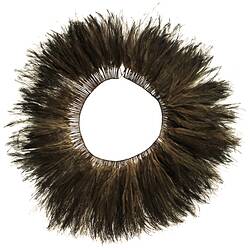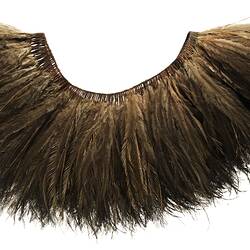Summary
Worn by women dancing in a corroboree, the emu-feather waist ornament is made from bundles of six or more emu feathers tied together. Once the feathers were secured into small bundles, they were then tied to a thin string-belt made from European fibre. Pre-contact, the string-belt was made using kangaroo sinews and a very fine cord made from possum fur; the same style of skirt was also made with alternating emu feathers and possum tails to create a thicker, shorter garment.
Local Name
Til-bur-nin
Physical Description
Apron made of emu feathers and a string belt.
Significance
Skilled Aboriginal craftswomen, such as Justice Nelson from the Jaara people of central Victoria, are reconnecting with this cultural practice of making emu feather skirts. Justice recently spent more than a week making an emu feather skirt for herself and her daughters to wear when dancing at the Yalukit Wilam Ngargee Festival in St Kilda, an annual event which celebrates Indigenous culture.
In early 2012 Justice and other members of the Yulendj group saw this emu-feather waist ornament for the first time. They explained the cultural knowledge and practices embedded in it, including the need to collect and choose the right emu feathers. The longer tail feathers were used for the back of the skirt and the smaller, downier feathers from under the wings to attach to the front of the skirt. The use of ochre on the feathers indicates it was most likely made and used for a ceremony. Many hours would have been spent making the hand spun string and preparing and attaching the numerous feathers.
More Information
-
Object/Medium
Ornament, waist
-
Maker
-
Locality
-
Date Produced
-
Object Measurements
575 mm (Length), 385 mm (Width), 110 mm (Height)
-
Classification
-
Date Made
-
Maker
-
Clan/Language Group
-
Place Made
-
Indigenous Region
-
Keywords
-
Collection Names
-
Type of item
-
Discipline
-
Category
-
Collecting Areas





